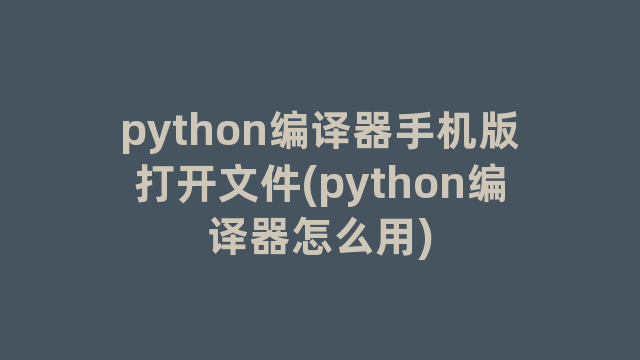
Python编译器手机版打开文件
Gone are the days when programming could only be done on a traditional desktop computer. With the advancements in technology, we now have the convenience of using Python compilers on our smartphones. In this article, we will explore how to open files using a Python compiler on your mobile device.
Choosing the Right Python Compiler for Mobile
Before we dive into opening files, it’s essential to select a suitable Python compiler for your smartphone. There are several options available in the market, each with its unique features and capabilities. Look for a compiler that offers a user-friendly interface, supports the latest Python versions, and provides a seamless file management system.
Accessing the File System
Once you have chosen a Python compiler for your mobile device, the next step is to access the file system. This is necessary to locate and open the desired file. Most Python compilers offer a built-in file explorer or a command-line interface to navigate through the files on your smartphone.
Locating the File
To open a file using a Python compiler on your smartphone, you need to know the file’s location. If you are unsure about the file’s exact path, you can use the file explorer provided by the compiler to search for it. Alternatively, if you know the file’s name, you can utilize the compiler’s search functionality to locate the file in your device’s storage.
Opening the File
Once you have found the file, it’s time to open it using the Python compiler. The process may vary slightly depending on the specific compiler you are using. Generally, you can use the “open()” function in Python to open a file. Make sure to specify the correct file path and mode (read, write, append, etc.) based on your requirements.
Reading and Modifying the File
After successfully opening the file, you can perform various operations on its contents. For example, if you want to read the file, you can use the “read()” function to retrieve its contents and display them on the compiler’s interface. Similarly, if you wish to modify the file, you can use the appropriate methods to write or append data to it.
Saving and Closing the File
Once you have finished working with a file, it’s crucial to save your changes and close it properly. Failing to do so may result in data loss or corruption. To save the changes made to a file, you can use the “save()” or “write()” function, depending on the compiler. Finally, remember to close the file using the “close()” function to free up system resources.
Conclusion
With the availability of Python compilers on mobile devices, developers can now conveniently open and work with files directly from their smartphones. By choosing the right compiler, accessing the file system, locating the desired file, and utilizing the appropriate functions, developers can seamlessly open, read, modify, and save files using Python. So, why limit your programming capabilities to desktop computers when you can tap into the immense potential of Python on your smartphone?
Embrace the power of Python on the go!
神龙|纯净稳定代理IP免费测试>>>>>>>>天启|企业级代理IP免费测试>>>>>>>>IPIPGO|全球住宅代理IP免费测试





